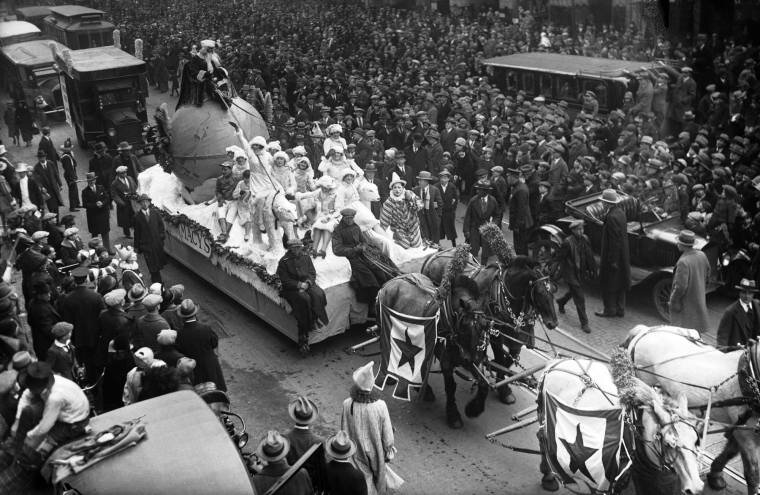While holiday gift-giving is a centuries-old tradition, the holiday shopping season is not – it was defined by of all things, parades! By the mid-20th-century parades were drawing large crowds and not just in large cities. Many parades were sponsored by local retailers (usually department stores), who by attaching their names to the parade, increased store visibility with holiday shoppers. Over time, Thanksgiving parades came to be seen as the unofficial start to the shopping season. In fact, Macy’s first parade on November 27, 1924 was advertised as a Christmas Parade with the arrival of Santa marking the official start to holiday shopping. (Note, the first few Macy parades included live animals from the Central Park Zoo, who were replaced with large balloon animals in 1927.)
Macy’s 1st Thanksgiving Parade 1924, Bettman Archive – Getty Images
But where does the term Black Friday come from?
Originally, the term was used to describe a financial crisis in 1869 when James Fish and Jay Gould worked together to buy up as much gold as possible ,to drive up the price and corner the market. However, their conspiracy unraveled on Friday, September 24, 1869, sending the stock market into a free-fall, ruining investors and tanking the economy. That day came to be known as “Black Friday.”
So if that’s where the term comes from, why is it associated with shopping? Well, we have to back up a bit.
President Lincoln designated the last Thursday of November as Thanksgiving and, as noted above, that day came to be known as the start of the holiday shopping season. This was fine until 1939, when Thanksgiving fell on November 30, leaving only 24 shopping days (actually, a bit less as most stores weren’t open on Sundays). President Roosevelt gave in to pressure and moved Thanksgiving up a week to allow more time for shopping. (Remember, this was during the depression and a longer shopping season was seen as good for the economy.) This move caused controversy and confusion, particularly because he made the declaration in October! Congress finally passed a law in 1941 making the fourth Thursday in November the official Thanksgiving holiday.
Franklin Thanksgiving, Bettman Archive – Getty Image
By the 1950s it was clear that many people were taking the Friday after Thanksgiving off work, giving themselves a four-day holiday and getting a head start on holiday shopping. Although the day after Thanksgiving isn’t a Federal holiday, many state and school employees were given the day off, increasing the number of potential shoppers. This came to a head in Philadelphia where the annual Army / Navy college football game takes place on the Saturday after Thanksgiving. Thousands of people flooded into the city to not only take in the game, but to shop. The combination of football fans and shoppers was a bad mix – city cops had to work extra-long shifts, deal with large crowds and traffic, and the headache of shoplifters who took advantage of the situation too. By the 1960s locals were calling the crazy day after Thanksgiving “Black Friday”, a name that stuck and spread.
Black Friday came into its own during the 1980s and 90s when large big-box stores like Walmart, Target and Best Buy advertised blowout sales. By the turn of the 21st century deal-hunters were camping out in parking lots and waiting in lines through the wee-hours of the morning to be the first to get bargains. At times, some crowds have turned a bit violent with fist-fights breaking out. There’s even a website called Black Friday Death Count!
Today Black Friday has to share space with Cyber Monday and Small Business Saturday, but Thanksgiving is still seen marking the start of holiday shopping.
If shopping isn’t your thing, a group in the UK (Buy Nothing Day ), invites people to escape the “Shopocalypse” by engaging in anti-commercial activities, suggesting you stay at home with a good book or organize a free concert, anything as long as you don’t buy anything.
All of us at the Scott County Historical Society wish you and yours a warm and filling Thanksgiving Holiday.
(FYI: The museum is closed for Thanksgiving and Black Friday – we’re eating goodies and shopping! The museum – and our museum store are open on Saturday.)








